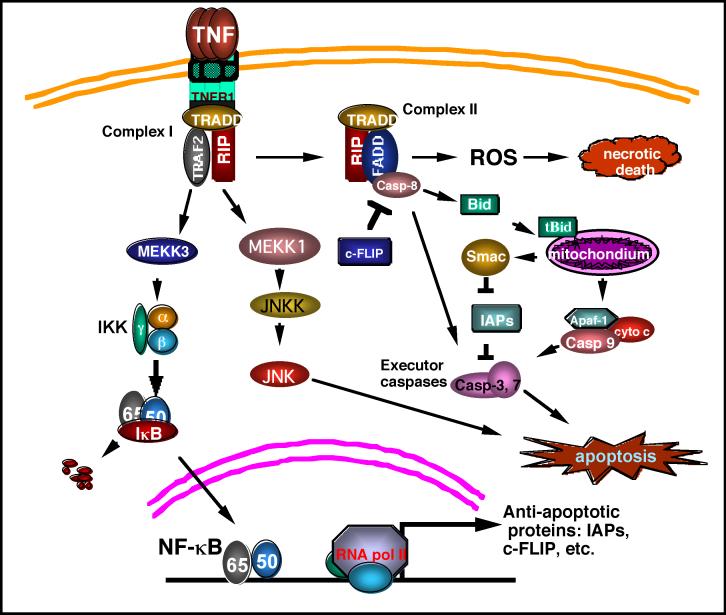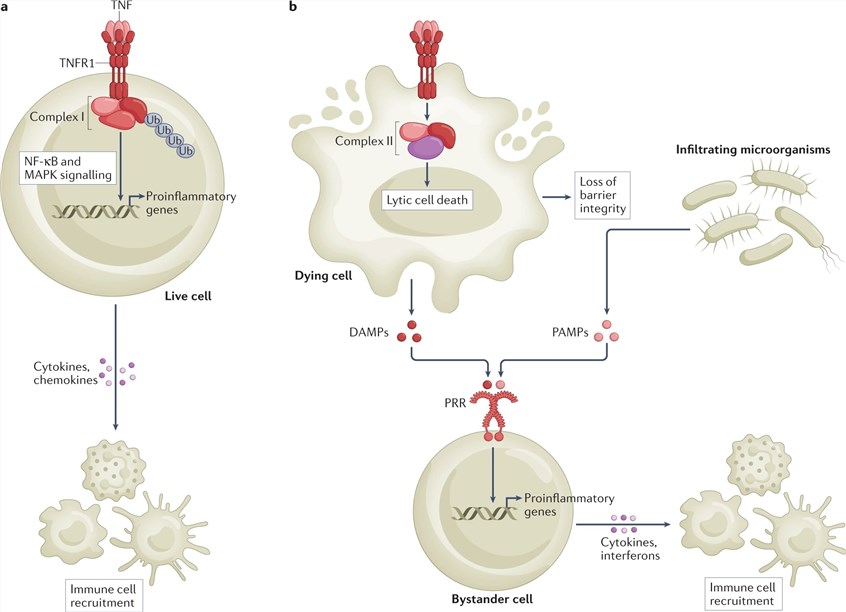Tumor Necrosis Factor (TNF)
Related Symbol Search List
- CD40 Ligand
- CD70
- EDA
- TNFB
- LTB
- TNFa
- TNFSF10
- RANKL
- TWEAK
- TNFSF12
- APRIL
- TNFSF13
- BAFF
- LIGHT
- TNFSF15
- Tnfsf4
- TNFSF8
- TNFSF9
Immunology Background
Available Resources for TNF Research
At Creative BioMart you can find a wide range of products related to TNF, including recombinant proteins and other key products. In addition, we offer customized services to meet your specific requirements, ensuring you get the product you need.
In addition to our products and services, we offer a wealth of resources for your reference. Our resources cover all aspects of TNF, including the involved pathways, protein function, interacting proteins, related articles, research areas, and other relevant topics. These resources will be invaluable to researchers wishing to deepen their understanding of TNF and their role in physiological processes.
Our Featured Products
About Tumor Necrosis Factor (TNF)
Tumor Necrosis Factor (TNF) is a cytokine that plays a crucial role in the immune system's response to infections, inflammation, and certain diseases, including cancer. It is primarily produced by immune cells such as macrophages, monocytes, and T cells.
TNF exists in two main forms: TNF-α and TNF-β. TNF-α, also known as cachectin, is the most studied and well-characterized form. It is responsible for initiating and regulating inflammation by activating various immune cells and promoting the production of other pro-inflammatory cytokines.
The primary function of TNF is to stimulate an immune response against harmful agents, such as bacteria, viruses, and tumor cells. It acts by binding to specific receptors on the surface of target cells, known as TNF receptors (TNFR), initiating a cascade of signaling events within the cell.
Physiological Functions of TNF
TNF plays several important physiological roles in the body. It is involved in various processes related to the immune response, inflammation, and tissue homeostasis. Here are some of the key physiological roles of TNF:
- Immune Response: TNF is a critical mediator of the immune response against infections. It promotes the activation and recruitment of immune cells, such as macrophages, neutrophils, and natural killer (NK) cells, to the site of infection. TNF also enhances the antigen-presenting capacity of immune cells, facilitating the recognition and elimination of pathogens. Moreover, TNF acts as a co-stimulatory signal for T cell activation and proliferation.
- Inflammation: TNF is a potent pro-inflammatory cytokine that plays a central role in initiating and amplifying inflammatory responses. It promotes the production of other pro-inflammatory mediators, such as interleukins (IL-1, IL-6), chemokines, and adhesion molecules, which recruit immune cells to the site of inflammation. TNF also increases vascular permeability, allowing immune cells to migrate to the affected tissues. While acute inflammation is essential for host defense and tissue repair, chronic or excessive TNF-induced inflammation can contribute to the pathogenesis of various diseases.
- Tissue Remodeling and Repair: TNF is involved in tissue remodeling and repair processes. It stimulates the production of extracellular matrix proteins, such as collagen, and promotes the migration and proliferation of fibroblasts, which are essential for tissue healing and scar formation. TNF also regulates endothelial cell function and angiogenesis, contributing to tissue repair and the formation of new blood vessels.
- Regulation of Cell Survival and Death: TNF plays a role in regulating cell survival and death processes. It can induce apoptosis, or programmed cell death, in certain cell types, particularly in the presence of inhibitors of apoptosis proteins (IAPs). TNF-induced apoptosis is important for the elimination of infected or damaged cells. However, TNF can also promote cell survival by activating signaling pathways that prevent apoptosis and promote cell proliferation and survival.
- Metabolic Regulation: TNF is implicated in the regulation of metabolism, particularly in the context of obesity and insulin resistance. Elevated levels of TNF have been associated with metabolic disorders, such as type 2 diabetes and obesity. TNF can disrupt insulin signaling pathways, leading to insulin resistance and impaired glucose uptake. It can also influence lipid metabolism, adipocyte function, and energy expenditure.
While TNF plays crucial roles in immune responses and tissue homeostasis, dysregulation of its production or signaling can contribute to the pathogenesis of various diseases. Excessive TNF production is associated with chronic inflammatory conditions, autoimmune diseases, and cancer. Conversely, impaired TNF signaling can lead to increased susceptibility to infections. Therefore, understanding the physiological roles of TNF is essential for developing therapeutic strategies to modulate its activity and treat related diseases.
 Fig.1 TNFR1 mediated signaling pathways. (Wang X, et al., 2008)
Fig.1 TNFR1 mediated signaling pathways. (Wang X, et al., 2008)
The binding of the TNF trimer to TNFR1 causes trimerization of TNFR1, resulting in formation of the Complex I consisting of TNFR1, TRADD, TRAF2 and RIP. Complex I mediates the NF-κB activation pathway through the MEKK3-IKK-IκB- NF-κB cascade, leading to expression of a battery of genes including those encoding antiapoptotic facvtors such as IAPs and c-FLIP. The JNK activation pathway is also mediated by Complex I. Sustained JNK activation is apoptotic. The internalization of the TNFR1 complex ensues formation of Complex II that contains RIP, TRADD, FADD and Caspase 8. Caspase 8 is autoactivated to trigger activation of the executor caspases −3, and −7, resulting in apoptosis. Cleavage of Bid by caspase 8 activates the mitochondrial apoptosis pathway that involves release of cytochrome c and Smac/DIABLO from mitochondria. Cytochrome c binds Apaf1 to activate caspase 9-mediated activation of executor caspases. The NF-κB activated factor c-FLIP suppresses caspase 8 activation while IAPs inhibit executor caspases. Smac released from the mitochndria suppresses IAPs to release the apoptosis brake. Complex II also mediates a necrotic cell death through ROS.
Signaling Pathways of TNF
TNF signaling pathways involve a complex network of intracellular signaling events triggered by the binding of TNF to its receptors on the cell surface. The two main TNF receptors are TNF receptor 1 (TNFR1) and TNF receptor 2 (TNFR2). Here is an overview of the major signaling pathways activated by TNF:
- NF-kB pathway: Upon binding of TNF to TNFR1, a signaling complex called the TNF receptor-associated death domain (TRADD) complex is formed. TRADD recruits several proteins, including TNF receptor-associated factor 2 (TRAF2), cellular inhibitor of apoptosis proteins (cIAPs), and receptor-interacting protein kinase 1 (RIPK1), leading to the activation of the NF-kB pathway. This pathway ultimately results in the translocation of the transcription factor NF-kB to the nucleus, where it regulates the expression of genes involved in inflammation, cell survival, and immune responses.
- MAPK pathway: TNF can activate the mitogen-activated protein kinase (MAPK) signaling pathway, which includes three major cascades: extracellular signal-regulated kinase (ERK), c-Jun N-terminal kinase (JNK), and p38 MAPK. Activation of these pathways leads to the phosphorylation and activation of various downstream targets, including transcription factors, which regulate gene expression involved in cell proliferation, differentiation, and apoptosis.
- Apoptosis pathway: TNF can induce apoptosis, or programmed cell death, under certain conditions. This occurs through the formation of a complex known as the apoptosome, which involves interactions between TNFR1, Fas-associated death domain protein (FADD), and caspase-8. The activation of caspase-8 triggers a cascade of caspase activation, ultimately leading to apoptosis.
- Cell survival pathway: TNF can also activate cell survival pathways to counterbalance its pro-apoptotic effects. This involves the activation of the NF-kB pathway, which promotes the expression of genes involved in cell survival and anti-apoptotic factors, such as inhibitors of apoptosis proteins (IAPs).
- Cell death pathways: In addition to apoptosis, TNF can induce other forms of programmed cell death, such as necroptosis and pyroptosis. These pathways involve the activation of RIPK1 and RIPK3 kinases and the formation of a complex called the necrosome. The necrosome triggers a series of events leading to cell death characterized by cell swelling, membrane rupture, and release of pro-inflammatory cellular contents.
It is important to note that the signaling pathways activated by TNF are highly context-dependent and can vary depending on the cell type, receptor subtype, concentration of TNF, and other factors. The balance between these signaling pathways determines the cellular response to TNF, whether it be pro-inflammatory, pro-survival, or pro-apoptotic. Dysregulation of TNF signaling can contribute to various diseases, and understanding these pathways is crucial for developing targeted therapies.
 Fig.2 Inflammatory signalling by TNFR1. (van Loo, G., et al., 2023)
Fig.2 Inflammatory signalling by TNFR1. (van Loo, G., et al., 2023)
a, Binding of tumour necrosis factor (TNF) to TNF receptor 1 (TNFR1) directly promotes inflammation by activating the nuclear factor-κB (NF-κB) and mitogen-activated protein kinase (MAPK) signalling pathways, which collectively lead to the transcriptional upregulation of genes encoding proinflammatory mediators, such as cytokines and chemokines.
b, TNFR1 activation also indirectly promotes inflammation by triggering cell death. Lytic forms of cell death, such as apoptosis-driven secondary necrosis, pyroptosis and necroptosis, release damage-associated molecular patterns (DAMPs) that activate proinflammatory gene expression in bystander cells. In addition, the inflammatory response may originate from and/or be amplified by loss of barrier function caused by epithelial cell death (lytic and non-lytic) and the subsequent sensing of pathogen-associated molecular patterns (PAMPs) from microorganisms that have breached the epithelial barrier. PRR, pattern recognition receptor.
If you have any questions, requirements, or cooperation intentions, please feel free to contact us. We very much look forward to working with you and helping you achieve research and commercial success.
References:
- Wang X, Lin Y. Tumor necrosis factor and cancer, buddies or foes? Acta Pharmacol Sin. 2008;29(11):1275-1288. doi:10.1111/j.1745-7254. 2008.00889.x
- van Loo, G., Bertrand, M.J.M. Death by TNF: a road to inflammation. Nat Rev Immunol 23, 289–303 (2023). https://doi.org/10.1038/s41577-022-00792-3

